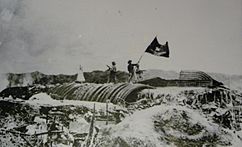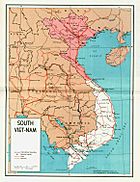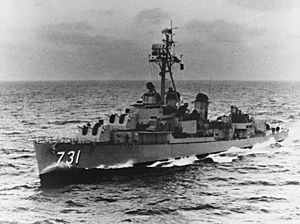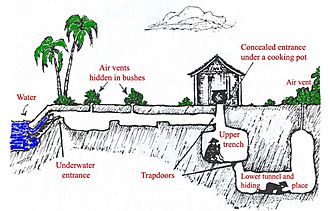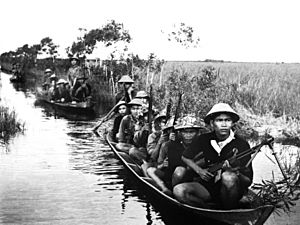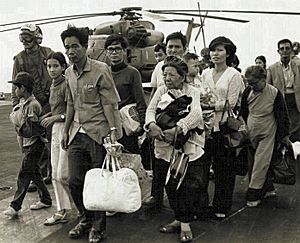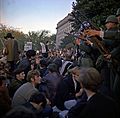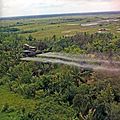Vietnam War facts for kids
Quick facts for kids Vietnam War(Chiến tranh Việt Nam) |
|||||||||
|---|---|---|---|---|---|---|---|---|---|
| Part of the Indochina Wars and the Cold War | |||||||||
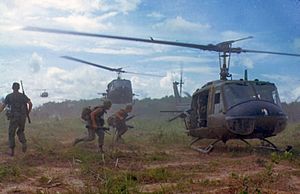 US helicopters in Vietnam, 1966 |
|||||||||
|
|||||||||
The Vietnam War was a long and difficult conflict. It lasted from November 1, 1955, to April 30, 1975. This war was fought between North Vietnam and South Vietnam.
North Vietnam had strong allies like the Soviet Union and China. South Vietnam was supported by the United States and other countries. These included South Korea, Thailand, Australia, and New Zealand.
This war was a big part of the Cold War. The Cold War was a period of tension between communist and capitalist countries. In Vietnam, it was a fight between two different ways of life.
A group called the Viet Cong fought in South Vietnam. They were a communist force helped by North Vietnam. They used a fighting style called guerrilla warfare. This means they used surprise attacks and hid well. The People's Army of Vietnam (North Vietnamese Army) also fought in bigger battles.
The Vietnam War was very controversial, especially in the United States. It was the first war shown live on television. It was also the first major war the United States lost. Many Americans wanted their soldiers to come home. President Richard Nixon eventually agreed to bring them back in 1973.
Contents
Why did the Vietnam War start?
Vietnam used to be a colony of France. France took control of different parts of Vietnam between 1859 and 1885. These areas were combined with Cambodia and Laos to form French Indochina.
During World War II, Japan took control of Indochina. After Japan lost the war in 1945, France wanted its colonies back. But a Vietnamese army called the Viet Minh resisted.
The Viet Minh was started in 1941 by the communist party. It was led by Ho Chi Minh. This led to the First Indochina War between France and the Viet Minh. The war ended when the Viet Minh won a big battle at Dien Bien Phu.
In July 1954, France and the Viet Minh signed the Geneva Peace Accord. This agreement divided Vietnam into two parts. North Vietnam was controlled by communists led by Ho Chi Minh. South Vietnam was led by Ngo Dinh Diem. The plan was to hold elections in 1956 to unite the country.
However, Diem started arresting people he thought were communist supporters. The elections never happened. In 1957, North Vietnam began fighting against the South.
The United States supported South Vietnam's government. They sent military advisors to help train the South Vietnamese army. The South was fighting the Viet Cong, a communist group in South Vietnam. The Viet Cong started attacking in 1957.
The U.S. believed in the domino theory. This idea said that if Vietnam became communist, other nearby countries would also fall to communism. This fear led to more U.S. involvement.
What was the Gulf of Tonkin Resolution?
On August 2, 1964, a U.S. ship called the USS Maddox was in the Gulf of Tonkin. The U.S. said that North Vietnamese torpedo boats attacked it. The Maddox fired back and damaged the boats.
Two days later, the U.S. claimed another attack happened. This time, the USS Maddox and USS Turner Joy were supposedly attacked. The U.S. ships did not see the torpedo boats. They said their radar showed the attack.
After these events, the U.S. launched air strikes against North Vietnam. On August 7, 1964, Congress passed the Gulf of Tonkin Joint Resolution. This gave the president power to use military force in Southeast Asia. This meant the U.S. could fight a large war without officially declaring it. Many people believed these attacks were an excuse for the U.S. to get more involved.
How did the Viet Cong fight?
Cross-sectional diagram showing an example of a section of tunnel system used by the Vietcong during the Vietnam War.
The area with the most tunnels was called the Iron Triangle by the Americans. The Viet Minh and later their successors the Vietcong used these tunnels.
Some of the larger tunnel complexes had kitchens, operating rooms, dorm rooms, storage rooms and school rooms.
Most of the fighting in Vietnam was guerrilla warfare. This is different from big battles between armies. In guerrilla warfare, small groups fight. They use surprise attacks, ambushes, and then disappear. They also try to make it hard for the enemy to operate. This includes using traps and sabotage.
The communist troops often used guerrilla tactics. They fought against the South Vietnamese and American soldiers.
They used many kinds of traps. Some traps used grenades with trip wires. If a soldier stepped on the wire, the grenade would explode.
Another trap was called "Venus Flytrap." It had sharp barbs that would catch a soldier's leg. When the soldier pulled their leg out, the barbs would rip their skin.
The Punji trap was very common. It had sharpened spikes hidden under leaves. When a soldier stepped on it, the spikes would go through their foot. These spikes were often dirty. This meant the soldier could get a serious infection.
These traps not only hurt soldiers but also made them scared. This lowered their spirits during the war.
What was the Ho Chi Minh Trail?
North Vietnamese and Viet Cong forces got their supplies through a huge network of hidden paths. This was called the Ho Chi Minh Trail. It was very well hidden.
Supplies and soldiers from North Vietnam traveled through Laos to reach communist forces in South Vietnam. American planes heavily bombed the Ho Chi Minh Trail. They dropped millions of tons of bombs. This slowed down the trail but did not stop it.
How did the war end?
In 1968, the communists suffered big losses during the Tet Offensive. This allowed the U.S. to start taking many soldiers out of Vietnam. This was part of a plan called "Vietnamization." South Vietnamese troops were trained to take over the fighting. By 1973, most American troops had left.
A peace treaty was signed in Paris in January 1973. All sides agreed to it. But fighting still continued until 1975.
The Fall of Saigon happened on April 30, 1975. Saigon was the capital of South Vietnam. North Vietnamese forces and the National Liberation Front captured it. This event ended the Vietnam War. It also led to Vietnam becoming one communist country.
Before the city fell, American civilians and military staff left Vietnam. Tens of thousands of South Vietnamese soldiers and civilians also fled.
North Vietnamese forces began their final attack on Saigon on April 29. They heavily bombed Tân Sơn Nhứt Airport. Two American servicemen died there. They were the last Americans to die in Vietnam.
By the next afternoon, North Vietnamese troops had taken over important places in the city. They raised their flag over the South Vietnamese presidential palace. The government of South Vietnam officially gave up shortly after.
Saigon was renamed Ho Chi Minh City, after the communist leader. The South Vietnamese president, General Duong Van Minh, announced the surrender. He said, "We are here to hand over to you the power in order to avoid bloodshed." General Minh had only been president for two days as the country collapsed.
Related pages
- First Indochina War
- Weapons of the Vietnam War
Images for kids
-
Soviet Premier Alexei Kosygin with U.S. President Lyndon B. Johnson at the Glassboro Summit Conference where the two representatives discussed the possibilities of a peace settlement
-
Ho Chi Minh with East German sailors in Stralsund harbour, 1957
-
Leonid Brezhnev (left) was the leader of the Soviet Union during the second half of the Vietnam War.
-
UH-1D helicopters airlift members of a U.S. infantry regiment, 1966
-
U.S. helicopter spraying chemical defoliants in the Mekong Delta, South Vietnam, 1969
See also
 In Spanish: Guerra de Vietnam para niños
In Spanish: Guerra de Vietnam para niños


